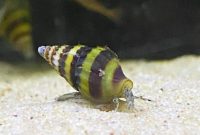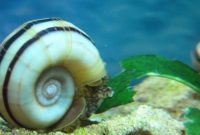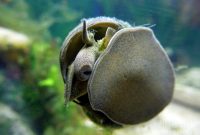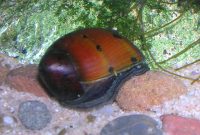The zebra nerite snails (Neritina Natalensis/Vittina Natalensis) are great algae eaters warriors. They belong to the neritdae family that can survive in freshwater and brackish water.
These species are famous among aquarists due to voracious grazing on most algae aquarium varieties and detritus. Besides that, this nerite snail type is easy to look after, friendly with their companions and does not need particular requirements, making them desirable pets.
In this care sheet, we will be guiding you to keep zebra nerite snails simply and straightforward, although doesn’t simple at all. So, let’s dive in!
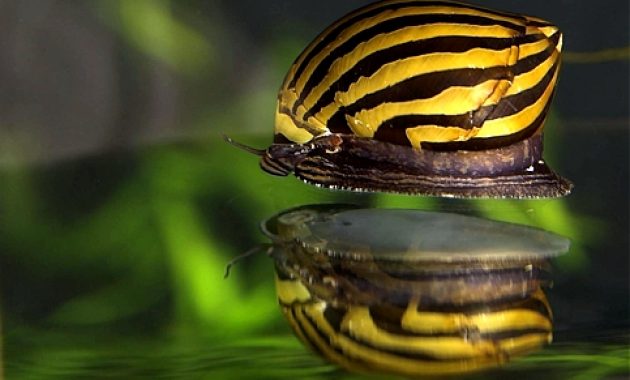
TABLE OF CONTENTS
Origin And Natural Habitat Of Zebra Nerite Snails
Neritina natalensis algae eaters are originally native to Africa, specifically Tanzania, Somalia, Kenya, South Africa, and Mozambique. In their habitat, they can usually be found in forests or mountain streams where freshwater algae flourish well on stones and crevices.
Some populations that live in a part of Eastern Africa inhabit brackish water areas, lagoons, and mangrove swamps. While the marine nerite snail varieties commonly occupy the Pacific or Caribbean coast.
The species name Natalensis refers to a province named in South Africa, ‘Natal,’ in which specimens of this species were discovered. Nowadays, this province is changed to KwaZulu-Natal. Zebra nerite snails are known can tolerate cold and warm water.
Appearance Of Zebra Nerite Snails
They are unique, striking, and interesting to see. Their shell shapes are pointing toward the center of the coil resembling liquid-drop.
These tiny aquarium snails have two primary colors, consisting of a series of gold and dark or yellow/yellow-lime and black stripes that run from a point at their shell tail.
Some have many thicker stripes, and the others may be thinner, look like pinstripes, or even irregular. It is possible for some species of zebra nerite to contain several rows of spots along the shells instead of full lines.
How big does a zebra nerite snail get? The adult ones can reach 1 inch (2.5 cm) in length. However, the aquarium stores usually sold them much smaller than that, measuring 0.3 – 0.5 inches often. In some cases, they could grow larger by around 1.5 inches under certain conditions.
Availability
Sadly, in their wild habitat, their population was decreased significantly and has been listed as near threatened by IUCN RED LIST since 2009 due to overcatching for commercial use; their habitation is broken due to human activities such as the development of houses & recreation areas, agricultural, industrial activities.
Nowadays, zebra nerite snails are easily found in trades at cheaper prices because many breeders produce these creatures for aquaria industries. Typically each zebra nerite snail costs about $4, but you may get an extra discount if you purchase them in a group bundle.
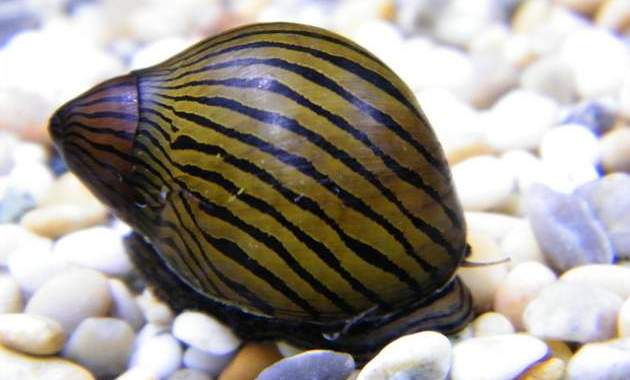
BUY LIVE NERITE ZEBRA SNAILS ONLY ON AMAZON
How Long Do Zebra Nerite Snails Live?
Averagely most nerite zebra that live in aquarium ecosystems have an expanding lifespan of about 2-3 years. But, according to experiences from some aquarists, these mollusks can reach up to 5 years under healthy planted tank environments.
Neritina Natalensis Sp. Zebra Behaviour And Temperaments
These aquatic invertebrates are very peaceful toward their tankmates without any violent streaks or bothering each other. Due to their small size, slow movement, and gentle nature, nerite zebra occasionally become prey for aggressive and larger fish, such as bigger gouramis species, and even predatory snails like assassin snails.
They tend to spend the whole time munching algae throughout the tank. When the food stocks begin to be harsh, they may climb the glass to go out of the tank, hoping to find new places with rich resources. Well, applying a tight-fitting aquarium lid is necessary to prevent them from escaping. Besides that, ensure the water level in your fish tank is not too high. It can reduce the possibility of them going outside of the aquarium.
Zebra snails tend to be more active during the night than in the daylight period (nocturnal). Keep watching out for your snails over time; if they fall to the ground while climbing or escaping from the tank, these creatures find it difficult to flip back their bodies. If they leave them upside down for a long time, they will suffer; the worst result is they may be dead in that way.
A simple aquascape setup design is preferable for these snails rather than the complex one since they could easily get stuck and lost.
Even though you keep a few zebra nerite snails in the same tank, they commonly do not make a group where they move some corners to another corner together; instead, they are individualistic. These aquascape snails really do not care about other friends of the same species and want not to be companied. So, you do not assume that keeping them alone inside the tank, nerite zebras would feel so lonely.
Do aquarium zebra nerite snails sleep? Yes, of course. But, they have a different sleep period and behavior from other aquarium creatures. Most aquascaping fish sleep at night and are active during daylight, but snails do not. The sleeping cycle of snails lasts for 2 until 3 days, and for about 13 hours or more, they sleep in 7 small bouts. After that, nerite snails can stay awake and active for 30+ hours until they need to repeat this sleep cycle.
If they get disrupted during the sleep process due to certain reasons, zebra snails seem to be able to continue as usual until their next set of seven bouts. It probably no give a significant effect on their health.
Snails can sleep for a long time, for about three years, through hibernation. However, it usually happens in land snails but not for aquatic species.
Are Zebra Nerite Snails Asexual?
Unlike most aquatic snail species, neritina natalensis is not hermaphrodite/asexual. Nerite zebra have distinct sexes between each other. Unfortunately, it is too hard to differentiate their gender from the naked eye because there are no external signs to see that.
If you want to try breeding zebra snails, you should make a group consisting of at least 5-6 individuals to enhance the possibility of acquiring both sexes.
Honestly, we found a hypothesis on the internet that said if the gender of nerite snails can be defined under a few particular conditions, including numerous individuals of the same age, grazing in the same environments, and consuming the same foods. As a result, the female zebra nerite snails usually can be signed with a slightly larger body than the males. Furthermore, the males commonly are marked with little folds around their right eyes, while the females are doesn’t.
We can not say whether this hypothesis is correct or not due to there are still no studies yet that write about sexuality in nerite snails, especially nerite zebras species.
Zebra Nerite Snails Algae Eaters Tank Setup
Neritina natalensis is hardy and easiest to care for; they are suitable for every tank owner with different experience levels. So, do not be worried about deciding about the setup if it’s the first time in kept these aquatic snails.
In order to set up a new aquarium for nerite, zebra snails are beginning with selecting substrate types. The fine-grained sand type is the best substrate for them. It is safe for soft parts of their body, like tentacles, because the rocky gravel may cause causing some wounds. They also can accept a muddy substrate.
How many zebra nerite snails per gallon? It is a very common question; you should provide at least 5 gallons for a single neritina natalensis. So if you have a 10-gallon aquarium, you can add two snails. Of course, if it can handle 20 gallons of water, it can accommodate 4 pieces.
In the wild, they can survive in freshwater and brackishwater, so choose what kind of tank ecosystem you want.
Generally, zebra nerite snails tolerate water temperatures measuring from 22 – 25° celsius (72 – 78° Fahrenheit), pH range from 7 – 8.4, and salinity level between 1.020 ~ 1.028 sg.
Low lighting levels are preferred by them, remembered neritina natalensis are more active at night. Nonetheless, they also tolerate an aquarium setup with a medium-high lighting system. Indeed, you should provide sufficient shaded areas for them to hide and chill by placing some rocks, driftwood, and aquatic plants.
Live aquarium plants are recommended to be added to their tank setup. It offers many benefits for zebra snails that impact their health level. The plants change carbon dioxide in the water into oxygen that they need to live. It roles as a field for several hair aquarium algae types, such as oedogonium, cladophora, rhizoclonium, spirogyra, staghorn, and black beard to grow. Some of them are favorite zebra nerite snails’ food. In addition, the selection of plants that match with fish tank design will give a very interactive view and many shady spots.
Strong water flow can be a risk factor for zebra nerite snails; it can cause them to fall and upside down when climbing a higher object, such as the tip of leaves or glass walls. Installing sponge filters and gentle hang-on or internal filter types could be a proper solution.
As they can adapt to various water parameters, frankly, installing a heater or chiller is unnecessary. You may add artificial decorations like plastic plants, caves, and other ornaments to their tank.
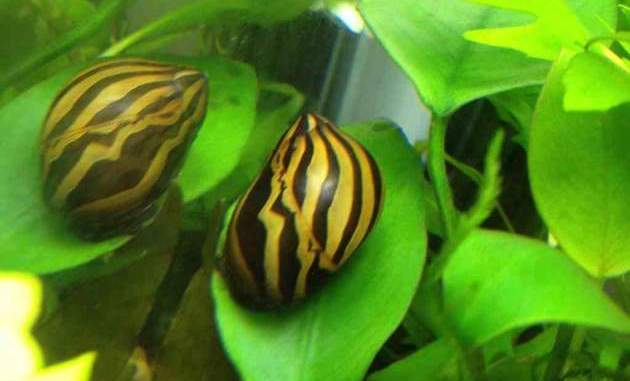
How To Care For Neritina Natalensis Algae Eaters
Zebra nerite snails do not require special requirements during keeping them in the fish tank as long as their dwelling place stays clean all the time.
Regular water change of about 30% weekly is essential. It could keep water quality stable and reduce ammonia and nitrate contents. Highly recommended to use reverse osmosis water; it is pure water without containing harmful substances like manganese that are usually found in tap water. You can turn the tap water at your home to deionize water using an RO water converter for aquarium use as much as you want. This tool is usually available on the online marketplace.
Never overfeed and underfeed your zebra nerite snails. The leftover food will build up at the substrate, which may lead to dangerous problems like algae presence, fungus, illness, and other harmful pests like planaria, detritus worms, and hydras.
PH level is a critical point in keeping freshwater aquarium snails. Neritina natalensis would grow optimally in a tank containing pH rates between 7-8, and they prefer hard water. While the softer water has high acid levels, which is harmful to them, it can dissolve nerite zebra shells made of calcium carbonate.
A larger tank is better for their survival rather than a smaller one. Add a few doses of calcium supplement regularly, making their shells stay hard. These snails are excellent escapers, so keep the water surface at least 3 inches lower than the top side of your aquarium. Putting a tank lid gives more anticipation to your little snails to get outside.
What Do Zebra nerite snails Eat?
Neritina natalensis is a fantastic aquarium algae eater; they are herbivores and detritivores. Green algae types are their favorable snacks, the gentle algae, green dust, hair types, green spots, brown ones, and even the stricter algae like black brush algae still can be consumed if there is no food stock left.
When the algae population ran out inside the fish tank, supplemented zebra nerite snails with other commercial food like algae wafers. They also accept blanched lettuce, broccoli, zucchini, and carrots.
Do zebra nerite snails eat aquarium plants? Luckily, unlike other aquatic snails, neritina natalensis is a kind of algae eaters that do not seem to chew the plants’ leaves, although when they feel hungry.
Breeding Zebra Nerite Snails In The Aquarium
Due to neritina natalensis is not asexual, you require at least a pair of adult snails in reproducing chapter. As mentioned above, it’s difficult to notice their sexuality directly; you should keep them in a small group of at least five to six individuals in the breeding tank.
Based on much-trusted information on the internet, breeding zebra nerite snails can be tricky because they need a specific condition. Most nerite snail varieties need saltwater ecosystems to generate their babies, but zebra snails only reproduce in brackish water.
Prepare a separate breeding tank to prevent their inhabitants from feeling disturbed during the breeding process and prevent young snails from being predated by fish. Use crushed coral for the substrate; it makes your tank rich in calcium. This content offers many benefits, especially in helping young snails develop their shells.
Add brackish water into the tank. It is slightly salty water; in order to create this, you should buy aquarium salts, then mix it with aquarium water. Take a hydrometer; it is helpful in measuring the specific gravity, where it’s closely related to the salinity level of water.
There is a specific density level to stimulate zebra nerite snails to breed, that is commonly ranges from 1.005-1.010. So, pour the salts into the breeding tank little by little, and after that, test the water in every addition until it reaches that level.
Apply the aquarium thermometer to test the water temperature. Actually, this factor is not crucial in this chapter; they can mate at various temperature levels. However, if your aquascape tank is a little bit warm, about 79 degrees Fahrenheit (26-27 degrees celsius). It can encourage the zebra nerite snails to spawn.
Keep in mind to feed them sufficiently on a regular basis. If your tank is running for some while, algae usually thrive in there. So, you may add a few additional snacks for them if necessary. But, if you breed these snails in a newer tank, sink algae wafer is important for their energy.
After that, wait for them to spawn. Zebra nerite snails will start to breed and release their eggs when they feel comfortable with tank environments.
During the mating process, the male nerite zebra snail will be positioned his body over the right side of the pair. Then, insert his genitalia below the female mantle edge. Next, she would use her foot to store the egg capsules on the surface of an object like wall glass or driftwood and fix it there.
Their egg capsules are yellowish when they first time is released, as time goes on, turning darker. Zebra nerite snails’ egg capsules are so tiny and shaped oval-like. Its size is around 1-1,5 millimeters in length and about 1 millimeter in width, surrounded by a thinner membrane to shield the eggs. Each capsule can accommodate about 32-106 eggs; however, it mostly contains about 68 pieces on average.
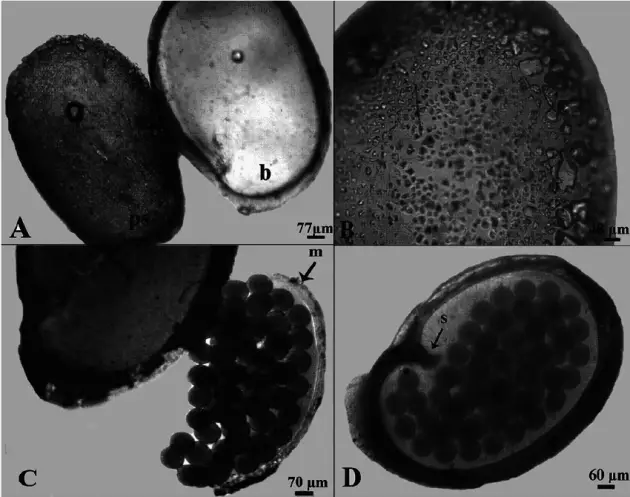
Once the eggs are hatching, they develop as planktonic larvae, called veliger. Salinity levels are vital in this process. According to a study, the capsules released veligers after 21 days in a salinity of 5 ppt. At a salinity of 10 ppt, the capsules released veliger faster, about 24 or 48 hours. Unfortunately, at the salinity of 15 ppt, this process is slower than at 5 ppt; it consumes about 25 days; although the veligers are well-formed but the eggs do not hatch at all.
In order to feed zebra nerite snails larvae, you may need this simple trick. The veligers are interested in a light source similar to Amano shrimp larvae. So, you can use a flashlight that is attached to a corner of the tank. When they gather at the right place, you can feed the majority of nerite zebra larvae at once.
What kind of food type that nerite zebra snail eats? There are several food types that are often found in the wild habitat, and you can replicate it in the aquarium environment.
- Algae – like matured snails, the larvae also feed on algae. Of course, its size fitted with them.
- Phytoplankton – It is their other favorite wild food type.
- Spirulina powder – you should mix this powder with water like infusoria.
- Golden pearls size 5-50 microns – these are commercial particles food that is available in stores. It is used for fish fry, and larvae, snails veligers also accept this food.
Feed them regularly, about 2-3 times daily; a small portion at each time is suggested rather than a big portion at one time.
How often do zebra nerite snails lay their egg capsules in the aquarium? This question still does not get a certain answer. In several cases, a few aquarists made a statement based on their experience; their snails released egg capsules frequently and hatched, even in the freshwater tanks making it flooded with young nerite zebras. While some said if their snails won’t spawn even kept in a breeding tank that is set up to mimic their habitat for mating.
The Best Tankmates For Zebra Nerite Snails
These peaceful aquarium creatures need some tankmates who have the same characteristics as them. You should be selective in choosing their friends; their small size and slow runner making zebra nerite snails became the easiest target to prey. Larger and more aggressive fish like botia macracantha, amazon puffer, pea puffer, cichlids, paradise gourami, and loaches are dangerous as tankmates. Carnivore snails like clea helena also are banned from their tank.
Keeping other calm algae eaters such as amano shrimps, siamese algae, or other snails makes the competition in getting food become harder. Below is a list of species that are advised for neritina natalensis tankmates;
Not only are predator fish vulnerable to them, but some smaller creatures, like common freshwater aquarium parasites such as planaria and hydra also harmful. It can kill both young and mature zebra nerite snails.
Zebra Nerite Snails Common Problems And Diseases
Under a particular condition and situation, they may be prone to certain health problems. If your snails have too much-eating vegetables, their shells will be discolored. This is a sign of stopping feeding them additional diet and leaving them just consuming algae in the fish tank.
If your zebra snail’s shell is cracked or damaged, it indicates that their shell is beginning to weaken. Adding calcium supplements can strengthen it back.
The elder zebra nerite snails are prone to edema; this condition can hamper them from moving. Sad to say, we still can not find any treatment to remedy this issue. So, ensure that your snails have the best quality of life.
Copper is poisonous for most aquarium snails. Well, never drop this substance into their aquarium at once. They also do not live well under lower oxygen-level tank environments. Ensure to keep the oxygen content is balanced.
Conclusion
Zebra nerite snails are an excellent cleanup crew for your planted aquarium. They are hardy and easy to care for, making them adaptable to most aquarium setups. Their population is able to be controlled so that can not be overpopulated if you want. Do not be worried if you put some high-valued aquarium plants; they tend to be uneaten it. Instead, they protect your plants from most algae invasions.


